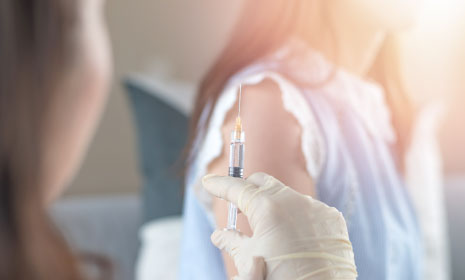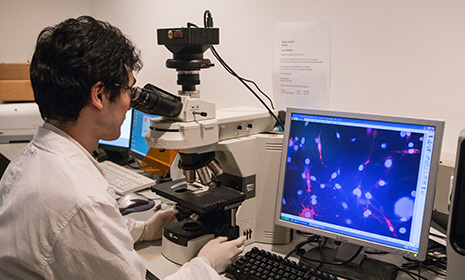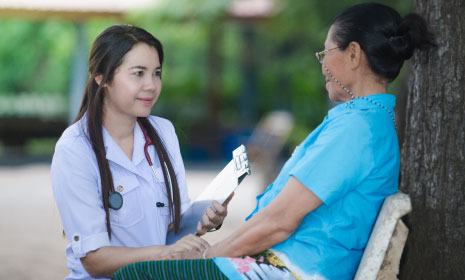HKU Reveals that Dose-sparing of Yellow Fever Vaccine is likely to be an Effective Strategy to Extend its Supply in a New Modelling Study
Fractionated dosing of yellow fever vaccines (where standard doses are split into five) is likely to be an effective strategy in order to extend the limited supply of vaccines and provide adequate population protection to control the outbreak in Angola and Democratic Republic of the Congo (DRC), according to a new modelling study conducted by HKU and international research teams. These findings have just been published in the prestigious international scientific journal, The Lancet, at http://www.thelancet.com/journals/lancet/article/PIIS0140-6736(16)31838-4/fulltext.
Research implications
The study analyses the likely effect of WHO’s emergency yellow fever vaccination campaign and finds that 5-fold fractional dosing is likely to be greatly beneficial if the efficacy of fractionated doses is equivalent to standard dosing, but still remains beneficial even if efficacy is lower than expected.
The authors, from The University of Hong Kong (China) and Harvard T.H. Chan School of Public Health (USA), say that roll-out of fractionated dosing should be accompanied by studies testing the safety and efficacy of fractionated vaccines during an epidemic.
Yellow fever
Angola has just experienced its worst outbreak of yellow fever in 30 years, and the epidemic has spread to the DRC and other countries with low yellow fever vaccine coverage. A broad band of sub-Saharan Africa (north of Namibia and Zambia)is at risk, as is much of northern South America.
There is a safe, highly effective vaccine against yellow fever. However, the global emergency stockpile of yellow fever vaccines, which was maintained at approximately 6.8 million doses before 2016, has already run out twice this year. Even with the production of 2-4 million doses per month, the vaccine supply is inadequate for the large populations at risk. Therefore, in July 2016 WHO allocated 2.5 million standard-dose vaccines to Kinshasa. Of these, 200 000 standard doses were given to children aged 9 months to 2 years and the remaining doses were divided into five in order to vaccinate the rest of the population in Kinshasa.
The WHO minimum potency for yellow fever vaccines is 1000 IU per dose, but some batches have been found to contain over 2 million IU per dose, suggesting that fractionated dosing may be feasible. Additionally, two randomised trials which concluded that 5-fold fractional dosing of the yellow fever vaccine was safe and triggered a non-inferior immune response in humans. However, there have been no randomised trials in human beings comparing the efficacy of different doses in preventing infection in areas where yellow fever is endemic.
Research method and findings
“We know from previous studies that lowering the vaccine dose by five times provokes a non-inferior immune response, and this provides a strong basis for WHO’s recommendation to deliver fractional dosing in order to extend supply, but we need careful assessment of this strategy and its potential effect on rates of infection,” says Dr Joseph T Wu, WHO Collaborating Centre for Infectious Disease Epidemiology and Control, and Associate Professor of School of Public Health, Li Ka Shing Faculty of Medicine, The University of Hong Kong. “This assessment is critical because even if dose fractionation reduces vaccine efficacy, higher vaccine coverage might confer higher herd immunity, in which case the number of infections would be reduced by the indirect effect of large-scale vaccination. The key is identifying how to optimise the limited number of doses.”
First, the research team estimated the reproductive number (i.e., the average number of cases generated from one case of yellow fever) of the Angola epidemic as 5.2-7.1. The lower the reproductive number, the lower the transmissibility of the disease and the larger the number of infections that can be averted by indirect protection from large-scale vaccination (herd immunity). Until now, the transmissibility of yellow fever in urban settings was unknown.
Before the WHO campaign, vaccine coverage in Kinshasa was estimated at about 20%. If all vaccines had been delivered as standard doses, the authors estimate that coverage would have increased to 37%. Without knowing the absolute efficacy of 5-fold fractional doses, the researchers modelled different possibilities. If the efficacy of the 5-fold fractional dose vaccine were 100%, then 99% of the population would be effectively immunised, suggesting that 7.1-7.85 million infections could be averted. At the lowest end of the scale, if the efficacy of the 5-fold fractional dose vaccine were only 30%, then 44% of the population would be effectively immunised, suggesting 1-1.25 million infections could be averted. The researchers therefore conclude that the WHO dose-sparing strategy is beneficial as long as 5-fold fractional vaccines are protective in at least 20% of the vaccinees.
“We found that as long as one in five vaccine recipients are fully immunised by the fractionated vaccine, more people would be immunised by vaccinating five times as many people with one-fifth of the dose compared to using the standard dose. In this instance, the benefits of mass vaccination would outweigh the lower efficacy of fractionated dosing for individuals,” explains Professor Marc Lipsitch, Harvard T.H. Chan School of Public Health. “Our study suggests that fractionated dosing would be greatly beneficial if efficacy is equivalent to standard dosing, but still remains beneficial even if efficacy is lower than expected.”
The authors also add that some doses of yellow fever vaccine far exceed the WHO minimum standard of potency of 1000 IU/dose, meaning that fractionated dosing could be done without dropping below that threshold. They warn that the modelling study used several assumptions, including that there was no seasonal variation in transmissibility, whereas in reality this would be affected by climatic conditions. Therefore they say that achieving high vaccine coverage before the rainy season is particularly important in order to maximise the effect of dose-sparing.
About the research team
This research was led by Dr Joseph TWu, WHO Collaborating Centre for Infectious Disease Epidemiology and Control, and Associate Professor ofSchool of Public Health, Li Ka Shing Faculty of Medicine, HKU, and Professor Marc Lipsitch, Professor of Epidemiology, Harvard T.H. Chan School of Public Health and Head of National Institutes of Health’s Center for Communicable Disease Dynamics. Other team members from the two institutions included Professor Gabriel M Leung, Chair Professor of Public Health Medicine and Dean of Li Ka Shing Faculty of Medicine, HKU, andMrCorey Peak of Harvard T.H. Chan School of Public Health.
About the WHO Collaborating Centre for Infectious Disease Epidemiology and Control at the School of Public Health, Li Ka Shing Faculty of Medicine, HKU
The School of Public Health, Li Ka Shing Faculty of Medicine of The University of Hong Kong has been designated as a WHO Collaborating Centre for Infectious Disease Epidemiology and Control (WHO CC) with effect from December 10, 2014. The designation of the HKU School of Public Health (HKU SPH) as a WHO CC is the first of such kind at the University. HKU SPH has a long and distinguished history in public health education and high impact research. With world leading research in infectious diseases as well as on non-communicable diseases of both local and global importance, the School has made significant contributions through its research and advocacy to improve the health of populations and individuals, both locally and globally. The School is a leading research and teaching hub in public health on influenza and other emerging viruses, control of infectious and non-communicable diseases, tobacco control, air pollution, psycho-oncology, behavioral sciences, life-course epidemiology, and health economics, health services planning and management. This work has informed international (e.g. the World Health Organisation, Food and Agriculture Organisation of the United Nations), national and local public health policies.
Media Enquiry
Please contact Ms Florence Cheng (Tel: 3917 9995/ 9107 1676) orMiss Pinky Yu (Tel: 3917 9306/ 6823 6796) of Li Ka Shing Faculty of Medicine, The University of Hong Kong.
Please visit the website at http://www.med.hku.hk/news/for press photo.








.png)
